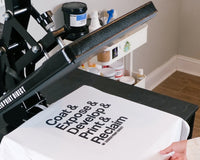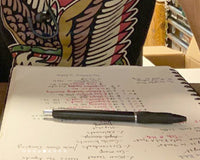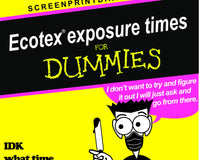Let’s talk about some common problems that you may encounter when working with screen printing emulsion. Emulsion can and typically is the biggest pain point when it comes to silk screening/ screen printing. We get questions daily regarding exposure times, how to wash it out or just simply how to get the emulsion to work. We would be lying to you if we said we can the perfect the process or make it seamless for you, but we can get you close. We have compiled a list of the most common emulsion issues and give quick easy tips to troubleshoot.
- Issues coating your screen with emulsion
Here are a few key points to remember when going to coat your screen. Do not over-fill or under-fill your scoop coater. Fill it about halfway and make sure the emulsion is spread throughout the coater evenly. Second, you want to hear contact between the mesh and your scoop coater, don’t be afraid to apply pressure to your screen. Next use whichever side you prefer on your scoop coater, some people will tell you to use the thick edge, and others will tell you to use the thin edge because it's better. The truth is, it’s up to you, the thick edge will lay down more emulsion and the thin side will lay down a thinner layer. What if my scoop coater just has one side? That works too.

Photo credit: Squeegee & Ink
Pressure and speed are first and foremost the most important to tackle and get right! Without the right pressure and speed during coating, you will get thin, non-even patches of emulsion. If you go slow and do not put enough pressure you will have a BIG mess on your hands, it’s not fun and sucks to clean up.
- There are streaks or lines in my coat of emulsion

Photo Credit: T-Shirt Forums
Sometimes you will notice streaks or lines in the coat. Look at your scoop coater and check the edges, do you have any dried-up particles of emulsion or anything else that may be sticking to the edge of your coater? Also, check for dust particles or anything else that may have landed on your screen that could cause lines or flaws in the emulsion during coating.
- Pieces of emulsion are washing off and some are washing off completely/ Emulsion isn’t washing out at all
Underexposed Emulsion: If your emulsion is losing detail in the stencil, blowing out and are washing out completely, it is underexposed, so increase exposure time.

Overexposed Emulsion: If your emulsion is not washing out when using a pressure wash to clear the image, it is overexposed, so lessen the time it is being exposed.
Under and overexposed emulsion is the most common screen-printing emulsion problem we come across with our customers. Dialing in exposure time is critical to creating a stencil for printing. We highly suggest an exposure calculator. We can’t tell you what your exact exposure time will be, as exposure time is dependent on the type of unit you use, and light source strength. An exposure calculator is a steadfast way to ensure proper exposure times.
Sometimes we have some emulsion particles peel or start to flake off after exposure. This will happen when you expose and washout your design out. This can and will most likely happen because of uneven coating or bad emulsion. You need to make sure you coat evenly and don’t try to go back and patch certain areas you missed. Patchwork will double the emulsion in the area that you had already covered. This is an all-too-common problem with new printers, they end up with super thick coats that take a lot of water to spray the image out. The image and unfortunately the emulsion will come off too in this case.
- Emulsion isn’t working
The most important thing to note about emulsion is that it is a light sensitive product. If you open your emulsion in a room with unsafe light, the emulsion will begin to expose prematurely and wont expose properly on your screen. With this said, make sure you handle emulsion in a light safe room with yellow or red light. It shouldn’t see any other type of light until your image is exposed onto the screen. Under no circumstances should your emulsion encounter light until it has been exposed.
If your emulsion still isn’t working, please read through the previous section titled “Emulsion is washing off completely/ Emulsion isn’t washing out at all.” If you still need assistance, contact us directly, we would be happy to assist.
- I can’t clean emulsion off of my screen
Sometimes screens can be hard to reclaim after the print job. The first thing is to make sure the screen has been properly exposed and cared for. A popular issue for having a screen that is hard to reclaim is letting your emulsion remover sit too long on the screen. Now a lot of beginners think “hey maybe if I let it sit a little longer it will penetrate better” … WRONG! If you let the emulsion remover sit longer thinking it will work better it’s going to do the complete opposite, it will make the screen irreclaimable. Irreclaimable = emulsion is permanently stuck on your screen, yikes :/
An easy way to prevent this is to follow the directions on your emulsion remover containers, simple right? Another important step that is often overlooked is water pressure, you need pressurized water to reclaim. Some people say they can reclaim with a water hose or sink facet, but we recommend a properly pressurized water solution. These can typically be purchased at your local hardware store as extension pieces to your water source.
- Where do I put the emulsion once I’m done with it? How long will it last?
We recommend storing your emulsion in a dark cool place. Many printers place their emulsion in the fridge, which is an excellent option. Emulsion can not freeze, if the emulsion freezes it will be unusable.
The shelf life of emulsion is dependent on the type of emulsion you are using. If you are working with a ready to use emulsion that does not require the addition of diazo, emulsion will be good to use for a year if stored properly. If you are working with a 2-part emulsion/ diazo required emulsion the shelf life is much shorter. 2 Part Emulsion shelf life is approx. 3 weeks once the diazo is added. We recommend only mixing the diazo and emulsion required for the job at hand so that you don’t compromise the shelf life of the entire container.
We have covered the biggest pain points when working with screen printing emulsion. If you have any other questions or need assistance please drop a comment below, we would love to help you resolve.
Let's Talk
Remember, we are here to help! Drop a comment below or email our support team at info@screenprintdirect.com








3 comments
Chris Hughes
Been frustrated, put an even coating, exposed at ten, whole image peeled off, restarted, at 14, same, then 20, same results, used the green emulsion for months never had this problem, even mixed nee emulsion and still the same, gave up after 4 attempts, idk what’s going on
Sherri Tayloe
Been having trouble getting my screens to wash out with the base layer green emulsion don’t know why I used it last time worked great and I bought the pink one the other day and then I realized that it needs diazo so now I have to order diazio did not know that it wasn’t ready mix you guys should stick a picture next to the thing saying you need this to go with it I hardly have time to order stuff let alone try and see what oh god I need that too s*** well I’m going to go figure out how to and how much I need for a gallon and then order it so that I can continue making some shirts so bummed. ,
Darian
Bought your pwr emulation because of shelf life of product but having trouble exposing tried both methods led 12sec and 500w 8 min it’s not burning the image even did thin and thick coat I’ve use your product before the WR emulations had great success with it